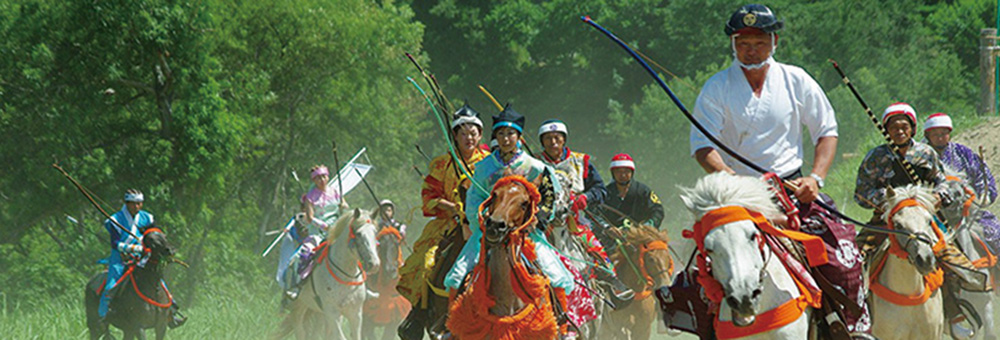


1.The Ideas Behind Yabusame As A Competition
2.The Difference Between Yabusame As A Shinto Ritual And Yabusame As A Competitive Sport
3.Reference – Yabusame Competition Rules
4.Certified Licenses
5.Yabusame Toranomaki
6.Media coverage
■To promote and retain Yabusame as a sport enjoyable for people of all ages and both sexes, while learning from ancient martial arts and responding to the atmosphere of the new era.
■To establish proper and fair competition rules for promoting the safe conduct of the competition and through which masterful and gorgeous techniques can be performed.
■To expand horse riding population with new utilization of horses and to promote Yabusame competition rooted in the community as a horse-based tourism.
Yabusame was derived from competitions held for improving the techniques for mounted archery when it dominated battlefields about 1,000 years ago. Yabusame requires fundamental horse riding skills to shoot arrows successively from a running horse. Over time Yabusame became a Shinto religious rite and took on its present form with various regional styles.
About 300 years ago, after the Era of Tokugawa Yoshimune who respected the spirit of martial arts, Yabusame was formed as a martial art and started being taught at quite a few schools. Even today some of those schools host Yabusame rituals at shrines along with other groups.
Going back to its origin as “shooting arrows successively from a running horse”, the Yabusame Federation aims to continue the tradition which has lasted over 1,000 years in Japan and to promote Yabusame as a competitive sport under defined competition rules. Also, for the purpose of accurately preserving the tradition, the usage of the traditional equipment including the saddle, stirrups, and snaffle is one of our substantial activities. One thing we should remember regarding equipment is that it has been developed along with Japanese horse breeds (the Japanese horse).
The difference between them is that one is a ceremony and the other is not, but in terms of archery and horse riding techniques nothing differs. In order to hand down Yabusame techniques to the next generation, the archers who perform Shinto rituals and the devotees of Yabusame competitions both collaborate with each other at the competitions. The local preservation societies expect that those collaborations will improve the problem of the shortage of successors to the Shinto ritual and horses used for Yabusame, and they also participate in joint activities.
【Yabusame As A Shinto Ritual】
■Ceremony
A Shinto ritual event of religious dedication is included.
■Rule
The event is conducted according to the traditional styles of each school. Usually women are not allowed to participate in the events.
■Horse
There is no rule about the breed of horses.
■Horse Equipment
A Japanese-style bit, a saddle with sandai (Three pieces of tack consisting of a bridle, martingale and crupper) and stirrups are used.
■Personal Equipment
・Japanese traditional style bow
・Japanese traditional style arrow (kaburaya or soya)
・There is no rule for draw weight
■Personal Dress
・Japanese traditional style
・Traditional costume of each Yabusame school
■Time Allowed
No upper or lower limits
【Yabusame As A Competitive Sport】
■Ceremony
None
■Rule
There are the competition rules that uphold the tradition and take safety and fairness into account. Regardless of age and sex everyone, including women and children, can participate.
■Horse
The horses shall be a Japanese breed or the 1st generation mixed breed of Japanese origin in principle. Any size shall be permitted. (There are some events in which only Japanese breeds compete)
■Horse Equipment
A Japanese-style bit, a saddle with sandai (Three pieces of tack consisting of a bridle, martingale and crupper) and stirrups shall be required in principle. Sangai is mandatory. (Some events don’t require Japanese-style equipment.)
■Personal Equipment
・Japanese traditional style bow
・Japanese traditional style arrow (kaburaya)
・To secure the safety, the arrow head has to be blunted and wooden with a diameter of 3 cm or larger.
・Draw weight has to be 10 kg for advanced class, 8 kg or less than 8 kg for intermediate class.
・The arrow length has to be at least 90 cm excluding the length of the kabura.
■Personal Dress
・Japanese style (traditional costume or Kyudo uniform, chest guard)
・Riding hats are mandatory.
・These rules apply also to overseas riders.
■Time Allowed
・Advanced class : Within 9 to 12 seconds
・Intermediate class: Within 9 to 14 seconds
・Novice : Within 9 to 17 seconds
1. Horses
The horses shall be a Japanese breed or the 1st generation mixed breed of Japanese origin in principle. Any size shall be permitted. Horses must be tested for equine infectious anemia.
2. Horse Equipment
A Japanese-style bit and a saddle with sangai (Three pieces of tack consisting of a bridle, martingale and crupper) shall be required in principle. Sangai is mandatory.
3. Personal Dress
・Riders shall wear Japanese traditional costumes and are encouraged to wear protectors.
・Riding hats or equivalent safety helmets with chin straps are mandatory.
4. Course
The Course Specified by the Tohoku Branch of The Yabusame Federation is as follows.
・180 to 200 m long
・2.5 to 3 m in width
・3 targets placed at intervals of 50 to 60 m
・3 to 4-meter distance to target
・Targets shall be set 30 cm to 2 m from the ground.
5. Personal Equipment
・The bows shall be of Japanese traditional form with a 10 kg draw weight for advanced riders. 8 kg is the maximum draw weight permitted for novice and intermediate riders.
・The arrow length shall be at least 90 cm excluding the length of the kabura (a wooden blunted arrowhead with a diameter of 3 cm).
6. Time Specified
The run time shall be measured from 5 m before the 1st target to 5m after the 3rd target.
・If the time for a run is less than 9s the competitor shall be disqualified for the purpose of avoiding injury.
・If the time for a run exceeds the maximum limit the competitor scores zero.
・For team competition the time will be measured from when the 1st rider passes the start line until the 3rd rider crosses the finish line.
7. Judging
Competitors shall follow the directions of the chief judge and judges positioned at the start and finish lines.
8. No Points
・A run is judged from when a rider passes the start line until the rider passes the finish line. If the competitor falls off the horse during the run he/she shall score zero.
・For team competition the competitors shall score no points if they overtake another rider or run side-by-side between the 1st target and the 3rd target.
9. Time Allowed
After a judge gives the signal competitors have 45 seconds to run through a specified point (placed at 25m to 30m before the 1st target), otherwise the competitors shall score no points. This time limit shall be applied to advanced riders, team competitors and single elimination tournament competitors.
10. Assistance in Leading A Horse into The Starting Gate
No assistance shall be permitted for advanced riders, team competitors or single elimination tournament competitors. This rule shall not be applied to novice and intermediate competitors.
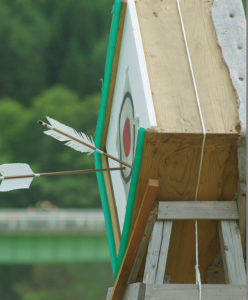
Shots will be scored if an arrow pieces the box target. This can be easily judged both by competitors and audiences.
The examination consists of a workshop and some exams on the Yabusame Federation competition rules and on safe and reasonable fundamental riding theory. The content is designated as a requirement to compete in the Federation’s official competitions, and it is aimed at expanding the horse riding population with a new utilization of horses and to promote Yabusame as a safe and enjoyable sport as part of horse-based tourism rooted in the local community. The system has been established also for the benefit of the competitors, so they will be informed of the essential requirements for making their own competitive techniques appreciated properly and of the latest trends in safety.
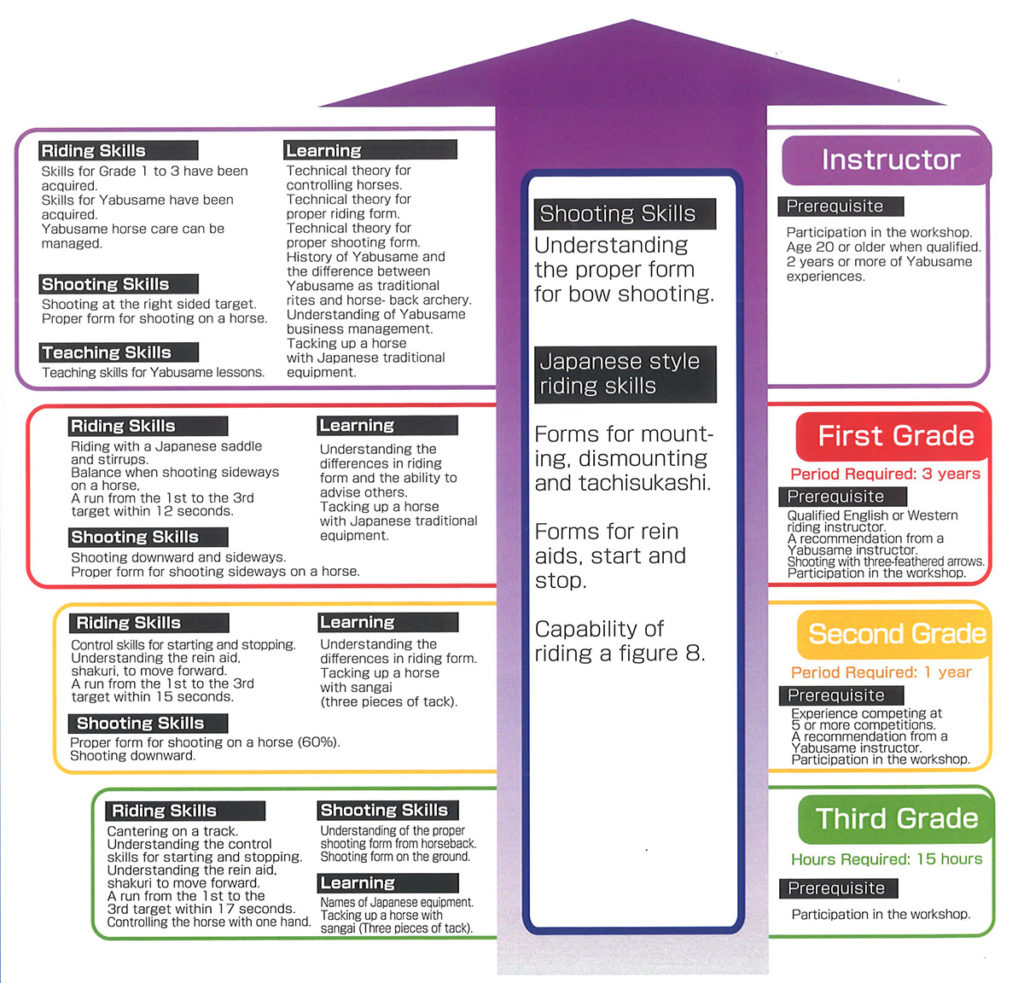
A Japanese Traditional Equestrian Martial Art And Its Revival As A Competitive SportYabusame Toranomaki(The Essence and Practice of Japanese Equestrian Archery)Kindle Edition

Accurate Riding Position And Shooting Technique Leads to a Hit.
Understanding and Learning Safe, Fun and Beautiful Yabusame Riding Techniques
Deepening the Knowledge of Traditional Horse Equipment.
A4 format. Full color. 40 pages.
This is a must-read text for competitive yabusame practitioners, created for all enthusiasts. The most theoretical technical book available, it uses photographs to explains harness and equestrian equipment and to describe the flow of the run.
Based on the nanbu yabusame handed down in the southern region stretching from Aomori Prefecture to Iwate Prefecture, it provides necessary information and detailed explanation encompassing technique and theory, disclosing verified results from Kasagakeki in the Gunsho Ruiju compendium of literature.
By introducing yabusame techniques with easy-to-understand color photographs and illustrations and by theoretically demonstrating the reasons for their effectiveness, the book provides an opportunity for enthusiasts who have learned through the senses to reconsider their techniques.
It is the definitive edition of competitive yabusame texts, useful for all enthusiasts from beginner to advanced practitioner.
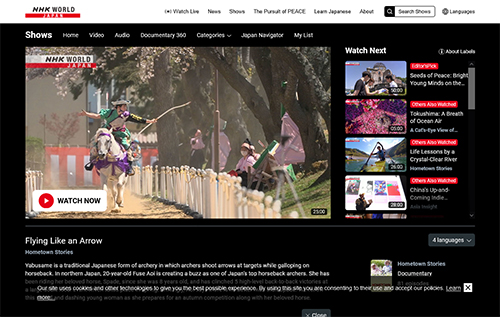
Flying Like an Arrow – Hometown Stories NHK WORLD-JAPAN
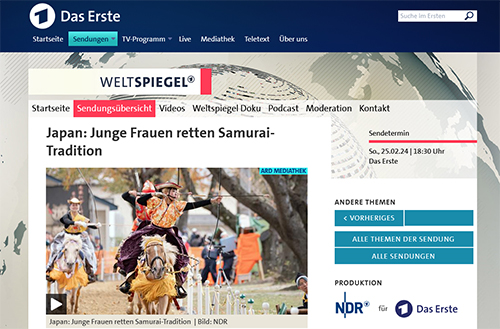
Japan: Junge Frauen retten Samurai-Tradition (Weltspiegel-ARD-Das-Erste)
【Arte 360°Reportage】Yabusame: Japan’s Woman Samurais (Available until 15/05/2025)
https://www.arte.tv/en/videos/111684-023-A/360-reportage/
Copyright © 十和田流鏑馬公式総合案内 All rights reserved.